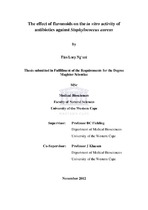| dc.contributor.advisor | Fielding, Burtram C. | |
| dc.contributor.advisor | Klaasen, J. | |
| dc.contributor.author | Ng’uni, Tiza Lucy | |
| dc.date.accessioned | 2015-11-05T08:15:50Z | |
| dc.date.available | 2015-11-05T08:15:50Z | |
| dc.date.issued | 2012 | |
| dc.identifier.uri | http://hdl.handle.net/11394/4636 | |
| dc.description | Magister Scientiae (Medical Bioscience) - MSc(MBS) | en_US |
| dc.description.abstract | Staphylococcus aureus is a Gram-positive coccus belonging to the Stapylococcaeae family. S. aureus causes a wide range of infections that range from skin infections to lifethreatening infections such as pneumonia and endocarditis and is the major cause of hospital and community-acquired infections. Despite antibiotics being available for the treatment of S.aureus infections, resistance to a number of antibiotics has developed over the years due to their improper and continuous use. S. aureus develops resistance to various drugs via different mechanisms, one of which is the extrusion of the antibiotics through efflux pumps that play a role in its acquisition of multidrug resistance. The ability of methicillin-resistant S.aureus to develop resistance to a variety of antibiotics is causing global concern as treatment options are being limited. Various antimicrobial studies carried out on purified plant-based flavonoids have shown that flavonoids enhance the antibacterial effect of antibiotics. This study analysed antibacterial effects of the antibiotics; tetracycline, ampicillin, methicillin and vancomycin and three flavonoids; chrysin, naringenin and 7-hydroxyflavone, against methicillin-sensitive ATCC 25923 (MSSA) and methicillin-resistant ATCC 33591 (MRSA) S. aureus strains, using the Kirby-Bauer disk diffusion and microtitre microdilution assays. In the Kirby- Bauer assay, the antibiotics demonstrated inhibitory effects on the growth of MSSA ATCC 25923. However MRSA ATCC 33591 was only susceptible to vancomycin, with minimal inhibition zones observed with ampicillin. The flavonoids did not enhance or reduce the antibacterial activities of the antibiotics as the zones of inhibition sizes remained unchanged in the combination studies. Microtitre assay results revealed that naringenin enhanced the antibacterial activities of the antibiotics tetracycline and ampicillin, against MSSA ATCC 25923 and MRSA 33591. This was evident as calculated synergistic ratios by the Abbot formula showed that naringenin had an additive effect. The presence of the efflux pump genes in MSSA ATCC 25923 and MRSA ATCC 33591 was compared using polymerase chain reaction (PCR). The mepA and gyrA genes were identified in both strains whereas sepA was identified in MRSA ATCC 33591. The presence of efflux pump genes in
both MSSA ATCC 25923 and MRSA ATCC 33591 also confirmed that the presence or absence of the genes may contribute to antibiotic resistance. The presence of sepA in the MRSA and not the MSSA confirmed that this gene plays a role in conferring drug resistance. | en_US |
| dc.language.iso | en | en_US |
| dc.publisher | University of the Western Cape | en_US |
| dc.subject | Staphylococcus aureus | en_US |
| dc.subject | Multidrug resistance | en_US |
| dc.subject | Flavonoids | en_US |
| dc.subject | Methicillin-resistant Staphylococcus aureus | en_US |
| dc.subject | Polymerase chain reaction | en_US |
| dc.title | The effect of flavonoids on the in vitro activity of antibiotics against Staphylococcus aureus | en_US |
| dc.type | Thesis | en_US |
| dc.rights.holder | University of the Western Cape | en_US |

